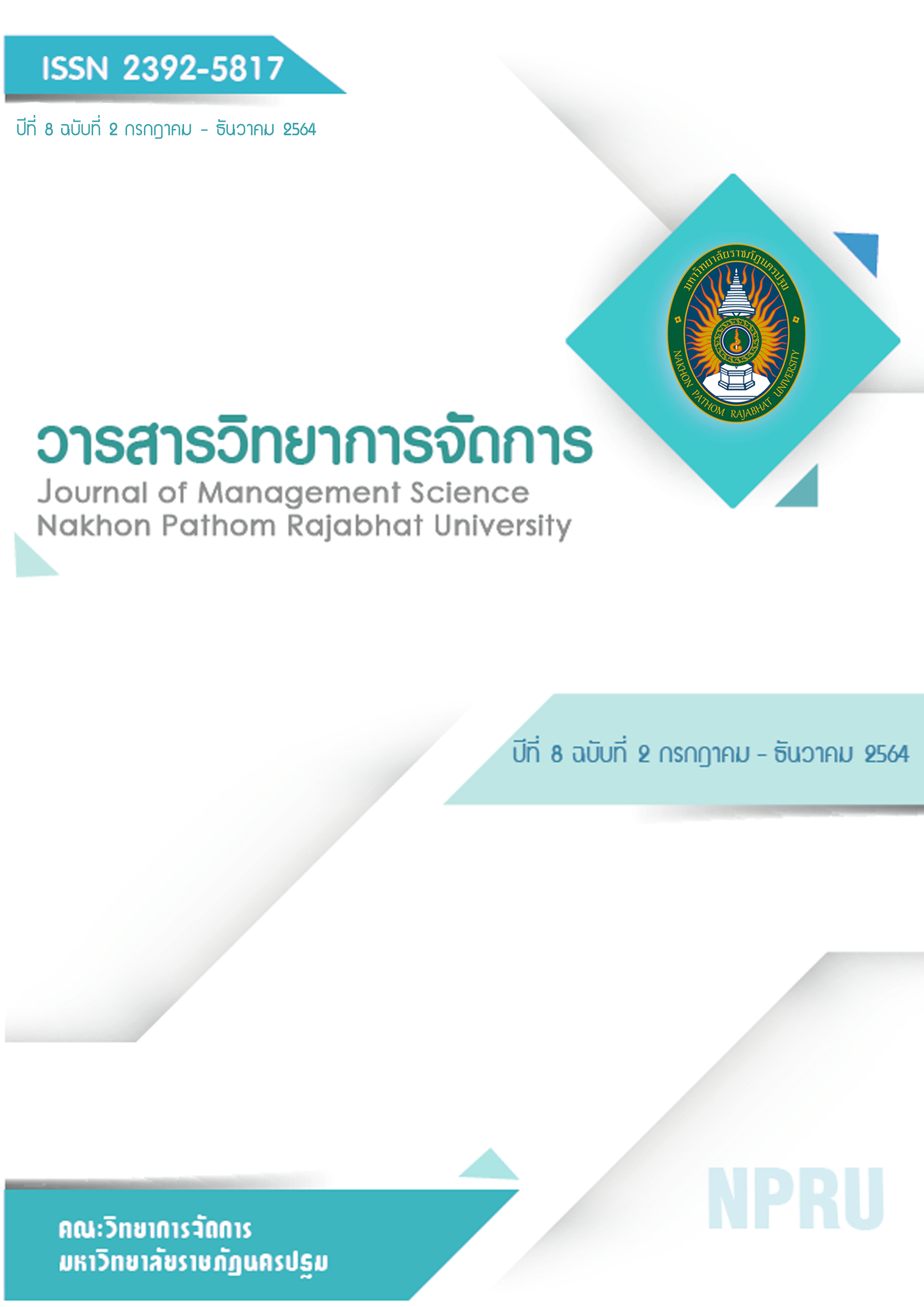ความสามารถในการจัดการนวัตกรรมเพื่อผลการดำเนินงานขององค์กร ของอุตสาหกรรมการเกษตรในประเทศไทย
Main Article Content
บทคัดย่อ
การวิจัยนี้มีวัตถุประสงค์ 1) เพื่อศึกษาอิทธิพลศักยภาพการพัฒนาทุนมนุษย์แบบพลวัต การจัดการการเปลี่ยนแปลงบนความหลากหลาย ศักยภาพการสร้างพันธมิตรทางธุรกิจแบบสร้างสรรค์ ส่งผลต่อความสามารถในการจัดการนวัตกรรมของอุตสาหกรรมการเกษตรในประเทศไทย 2) เพื่อศึกษาอิทธิพลของความสามารถในจัดการจัดการนวัตกรรมที่ส่งผลต่อการสร้างคุณค่าร่วมกันบนความเป็นเลิศทางการแข่งขันของอุตสาหกรรมการเกษตรในประเทศไทย 3) เพื่อศึกษาอิทธิพลของความสามารถในการจัดการนวัตกรรมที่ส่งผลการดำเนินงานองค์กรขององค์กรที่ยั่งยืนของอุตสาหกรรมการเกษตรในประเทศไทย 4) เพื่อศึกษาอิทธิพลของการสร้างคุณค่าร่วมกันบนความเป็นเลิศทางการแข่งขันที่ส่งผลการดำเนินงานองค์กรขององค์กรที่ยั่งยืนของอุตสาหกรรมการเกษตรในประเทศไทย การวิจัยนี้เป็นวิจัยเชิงปริมาณกลุ่มตัวอย่างที่ใช้คืออุตสาหกรรมการเกษตรในประเทศไทย จำนวน 320 แห่ง เครื่องมือที่ใช้ในการวิจัยเป็นแบบสอบถาม ประกอบด้วย ร้อยละ ความถี่ ส่วนเบี่ยงเบนมาตรฐาน (S.D.) ค่าเฉลี่ย (Mean) สำหรับสถิติที่ใช้ในการทดสอบสมมติฐาน ค่าดัชนีชี้วัดความกลมกลืน และผลการตรวจสอบความสอดคล้องกับข้อมูลเชิงประจักษ์มีความสอดคล้องกัน โดยผลการวิเคราะห์ข้อมูล พบว่า ค่า chi-square = 63.02 ระดับความมีนัยสำคัญ (p-value) =0.30 ค่าดัชนีวัดความกลมกลืนเชิงสัมพัทธ์ (CFI) = 1.00 ค่าดัชนีวัดความกลมกลืน (GFI) = 0.98 ค่าดัชนีวัดความกลมกลืน (AGFI) = 0.96 และค่ารากที่สองของค่าเฉลี่ยความคลาดเคลื่อนกำลังสองของการประมาณค่า (RMSEA) = 0.02
ผลการวิจัยพบว่า 1) ศักยภาพการพัฒนาทุนมนุษย์แบบพลวัต การจัดการการเปลี่ยนแปลงบนความหลากหลาย ศักยภาพการสร้างพันธมิตรทางธุรกิจแบบสร้างสรรค์มีอิทธิพลทางตรงในเชิงบวกต่อความสามารถในการจัดการนวัตกรรมของอุตสาหกรรมการเกษตรในประเทศไทย 2) ความสามารถในการจัดการนวัตกรรมมีอิทธิพลทางตรงในเชิงบวกต่อการสร้างคุณค่าร่วมกันบนความเป็นเลิศทางการแข่งขันของอุตสาหกรรมการเกษตรในประเทศไทย 3) ความสามารถในการจัดการนวัตกรรมมีอิทธิพลทางตรงเชิงบวกต่อการดำเนินงานองค์กรขององค์กรที่ยั่งยืนของอุตสาหกรรมการเกษตรในประเทศไทย 4) การสร้างคุณค่าร่วมกันบนความเป็นเลิศทางการแข่งขันมีอิทธิพลทางตรงในเชิงบวกต่อผลการดำเนินงานองค์กรขององค์กรที่ยั่งยืนของอุตสาหกรรมการเกษตรในประเทศไทย และประโยชน์จากการวิจัยนี้เป็นแนวทางให้อุตสาหกรรมมีการวางแผนนำหลักการไปใช้ให้มีผลการดำเนินงานขององค์กรที่ยั่งยืน
* วิทยานิพนธ์หลักสูตรปรัชญาดุษฎีบัณฑิต สาขาวิชาการจัดการ คณะวิทยาการจัดการ มหาวิทยาลัยศิลปากร 73000
ภายใต้การควบคุมของ ผู้ช่วยศาสตราจารย์ ดร. วิโรจน์ เจษฎาลักษณ์ผู้ และผู้ช่วยศาสตราจารย์ ดร. จันทนา แสนสุข
Corresponding author: pimon124@gmail.com
Article Details
ทัศนะและข้อคิดเห็นของบทความที่ปรากฏในวารสารฉบับนี้เป็นของผู้เขียนแต่ละท่าน ไม่ถือว่าเป็นทัศนะและความรับผิดชอบของกองบรรณาธิการ
References
Chiang, Y. H., & Shih, H. A. (2011). Knowledge-oriented human resource configurations, the new product development learning process, and perceived new product performance. The International Journal of Human Resource Management, 22(15), 3202-3221.
Chien, S., Tsai, C. (2012). Dynamic capability, knowledge, learning, and firm performance. Journal of Organizational Change Management, 25(3), 434-444.
Craciun, E. (2015). Human Capital – A Quality Factor for the Competitiveness of IT Companies. Leadership and Strategy in the Context of Changing Power Poles, (21), 44-51.
Crook, T. R., Todd, S. Y., Combs, J. G., Woehr, D. J., & Ketchen, D. J. (2011). Does human capital matter? A meta-analysis of the relationship between human capital and firm performance. Journal of Applied Psychology, 96(3), 443–456
Cronbach, L. J. (1984). Essential of psychology testing. New York: Harper.
Hair, J. F., Black, W. C., Babin, B. J., Anderson, R. E., & Tatham, R. L. (2006). Multivariate data Analysis. (6th ed.). Uppersaddle River: Pearson Prentice Hall. European Business Review, 20(4), 298-314.
Harimukti, W., Harm-Jan, S., & Aard, G. (2018). Exploring stakeholders’ support in International equity placement strategic alliance. Gadjah Mada International Journal of Business, 20(2), 205-228.
Intan-Soraya, R., & Chew, K. W. (2010). A framework for human resource management in the knowledge economy: Building intellectual capital and innovative capability. International Journal of Business and Management Science, 3(2), 251.
Jasra, J. M., Hunjra, A. I., Rehman, A. U., Azam, R. I., & Khan, M. A. (2012). Determinants of business success of small and medium enterprises. International Journal of Business and Social Science, 2(20)
Jeongeun, S., Tae-Eung, S., & Hyun-Woo, P. (2018). A network analysis of strategic alliance drivers in ICT open ecosystem: with focus on mobile, cloud computing and multimedia. Multimedia Tools and Application, 77(12), 14725-14745.
Kline, R. B. (2011). Principles and practice of structural equation modeling. (3rd ed.). New York, N: The Guilford Press.
Lawson, B., & Samson,D. (2011). Developing innovation capability in organizations: A dynamic capabilities approach. International Journal of Innovation Management, 5(3), 377-400.
Likert R. (1967). The Human Organization: Its Management and Value. New York: McGraw-Hill company.
Maglio, P., Vargo, S. L., Caswell, N., & Spohrer, J. (2009). The service system is the basic
abstraction of service science. Information Systems and E-Business Management,
7(4), 395–406
Mehta, C., & Gupta, P. (2014). Sculpting Future Leaders: An Intrapreneurial Approach. Global Journal of Finance and Management, 6(4), 313-320.
Merchant, K. A., & Van der Stede, W. A. (2007). Management Control Systems. (2nd ed.). England: Pearson Education Limited.
Office of the National Economics and Social Development Council. (2017). Summary of Draft The 12th National Economic and Social Development Plan (2017-2021). Retrieved February 5, 2020, from http://www.nesdb.go.th.
Pallant, J. (2010). SPSS survival manual: A step by step guide to data analysis using SPSS. Maidenhead. Open University Press/McGraw-Hill.
Peter Hazell and Stanley Wood. (2007). Drivers of change in global agriculture, The Royal Society.
Protogerou, A., Caloghirou, Y., & Lioukas, S. (2011). Dynamic capabilities and their indirect impact on firm performance. Industrial and Corporate .21(3)1-14.
Prahalad, C. K., & Ramaswamy, V. (2004). The future of competition: Co-creating unique value with customers. Boston: Harvard Business Review Press.
Prahalad, C.K., Ramaswamy., V. (2004). Co-creation experiences: The next practice in value creation. Journal of Interactive Marketing, 18(3), 5-14.
Prunea, A. (2014). Competitive Advantage in the Enterprise Performance. Annals of the University of Oradea. Economic Science Series, 23(1), 524-531.
Rubin, A. (2012). Statistics for evidence-based practice and evaluation. US: Cengage Learning.
Santos, J. B., & Brito, L. A. L. (2012). Toward a subjective measurement model for firm performance. Brazilian Administration Review, 9(6), 95-117.
Shiavone, F.,Metallo, C., & Agrifoglio, R. (2014). Extending the dart model for social media. International Journal of Technology Management, 66(4), 271-287.
Shu, C., Zhou, K. Z., Xiao, Y., & Gao, S. (2014). How Green Management Influences Product Innovation in China: The Role of Institutional Benefits. Journal of Business Ethics, 133(3), 471-485.
Tidd, Joe, & John Bessant. (2009). Managing Innovation Integrating Technological and Organization Change. (4th ed.). West Sussex : John Wiley and Sons.
Theodorakopoulos, N., & Budhwar, P. (2015). Guest Editors' Introduction: Diversity and Inclusion in Different Work Settings: Emerging Patterns, Challenges, and Research Agenda. Human Resource Management, 54 (2), 177-197. doi:10.1002/hrm.21715
Ukenna, S.I., Carol, N.A., & Olise, M.C. (2010). Effect of Investment in Human Capital Development on Organizational Performance: Empirical Examination of the Perception of Small Business Owners in Nigeria. European Journal of Economics, Finance and Administrative Sciences, 26(11), 93-107
World Economic Forum. (2016). The Global Competitiveness Report 2015-2016. Retrieved January 20, 2018 from http://reports.weforum.org/global-competitiveness-report-2015-2016.
Zhou, K. Z., & Li, C. B. (2010). How strategic orientations influence the building of dynamic capability in emerging economies. Journal of Business Research, 63(3), 224-231.

